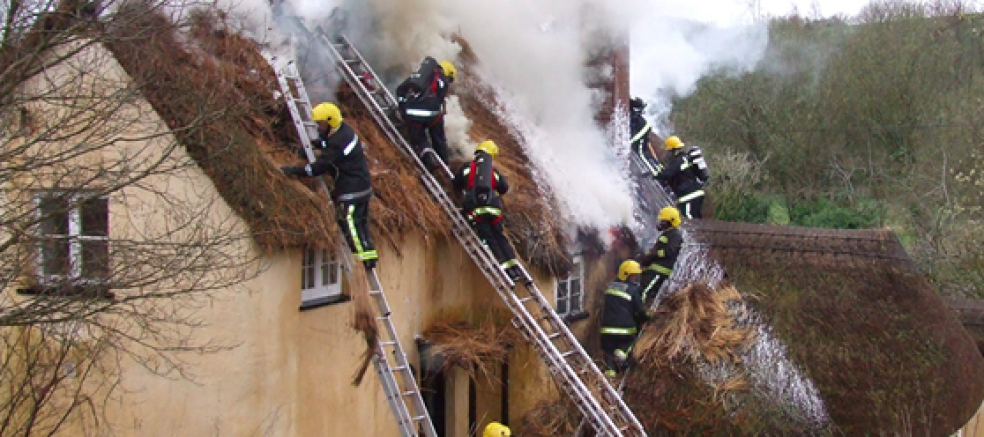
Five thatch fires so far this year!
Devon & Somerset Fire & Rescue Service remind owners of thatched properties to ensure their homes are safe from the risk of a fire. This advice comes due to the fact that the Fire Service has already attended five thatch fires this year.
Fire in thatch is not an inevitable occurrence but it is an organic material, subject to different behaviour patterns depending on its surroundings, treatments and choice of materials or styles. It has a finite life span, measured in tens rather than hundreds of years. And above all it is combustible.
Watch Manager, Paul Chamberlain from Taunton, White Watch recently attended two major thatch fires within eight days of each other and wanted to remind thatch owners of the steps to take to reduce the chance of an emergency relating to fire occurring.
Fire in a thatched roof is difficult to detect and once started is almost impossible to control. Once a fire has taken hold within a roof it will spread rapidly, due to the very nature of how thatch burns and detection is often too late and invariably devastating!
Many thatch fires are chimney-related. Modern enclosed solid fuel appliances are designed to burn efficiently and cleanly, often flues pass through old chimneys, where there is only a four-inch thickness of brick, which makes the thatch especially vulnerable to the risk of heat build-up and eventually combustion at a point between the brick and the thatch.
During both incidents Paul attended, members of the public asked why the fire service covers the property in compressed foam. They are several reasons for this:
It uses less water and often rural areas have a limited water source. So the foam gives a continual firefighting capacity.
Water damage to the property is also reduced both inside and out so we have the potential to salvage more personal possessions.
Paul explained further: “The foam is used like a blanket over the thatch to slowly soak in. Thatch is naturally designed to keep out the elements - one of these being the rain - so water will simply run off it. The best example is that it is very similar to your own skin when you pour water on it runs off. But if you have a long soak in the bath after a while your skin starts to absorb the water and goes wrinkly. That is basically what the foam does as it soaks into the thatch and has a cooling and wetting ability to stop the spread of fire.
“We also use a lance to further wet the thatch so we can create a fire break which is literally pulling a strip of thatch off to stop the spread of fire.”
To ensure firefighters are operational as quickly as possible upon arrival, Paul added: “If thatch owners could supply the fire service with the switching off points for their water, electric and gas. By isolating these points when we arrive (which we have to for the safety of firefighters) it allows us to be more effective sooner. If you have plans of the layout of the building, even if they are hand drawn, this is also ideal as the Incident Commander can relate this information to the crews, so any valuables that need to be salvaged in the time allowed can be targeted.”
Thatch information
The danger zone for heat transfer and where a fire may start in a thatch is more associated with older and/or listed properties with any two or more of the conditions highlighted below:
· A deep multi-layer thatch where the thatch is over one metre deep–a guide to the depth of thatch can be assessed in relation to the level of visible chimney
· Originally chimney height would have been about two metres from the ridge.
· Regular use of a multi-fuel or wood burning stove or an open fire with an inappropriate, old or poorly fitted liner
· Central chimney surrounded by thatch or a house that is part of a terrace
· Electrical faults and careless workmen, any recessed halogen spot lights, those particularity in bedroom or bathroom ceilings
· Security Lights - situated too close to the eaves. Any outside lights, particularly those fitted with motion sensors should be installed at least 1 metre away from any thatch
· Discarded cigarettes and garden bonfires
· Television aerials on thatched buildings should be fitted to a freestanding pole. Where this is not possible, the aerial should be fixed to a gable or gable-end chimney, where the cable can be run down the wall, avoiding contact with the thatch. Disconnect your television aerial during electrical storms to prevent damage to the system
Wood burning stoves
The increased efficiency of such stoves, whilst very welcome to residents of otherwise draughty older properties, has its own implications with regard to fire risk.
For more information please visit Wood burning stoves.
It is the combination of deep thatch and a central chimney in conjunction with the use of multi-fuel stoves that put properties most at risk.
If in doubt, ask and don’t use any chimney related appliance until you are sure it is safe!










